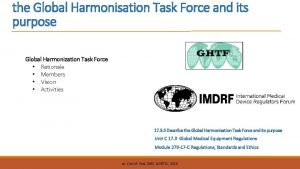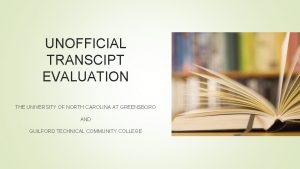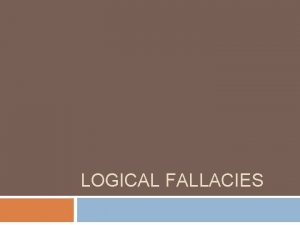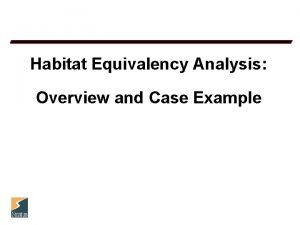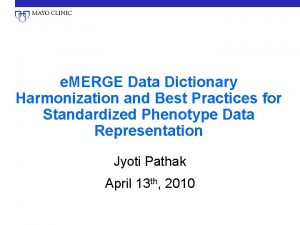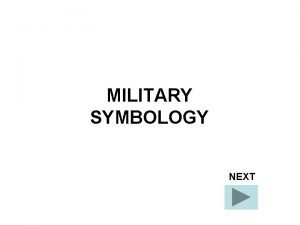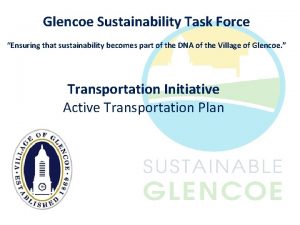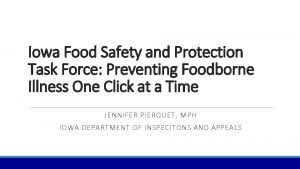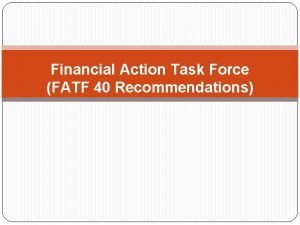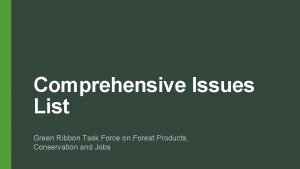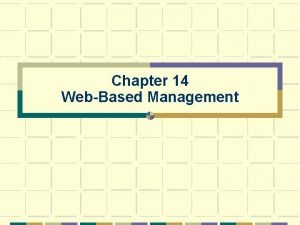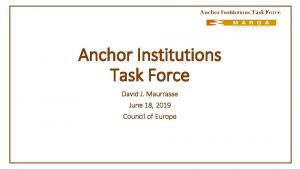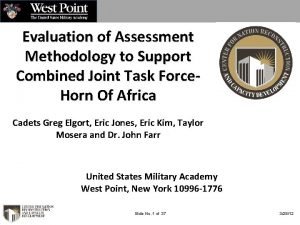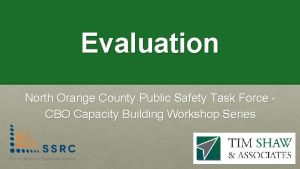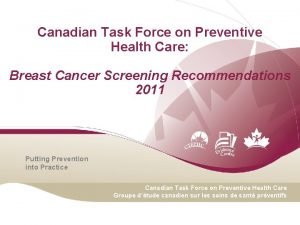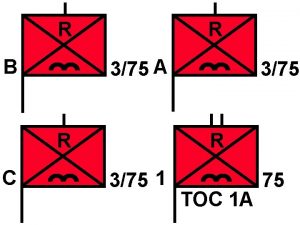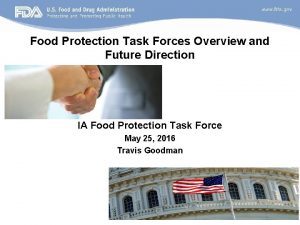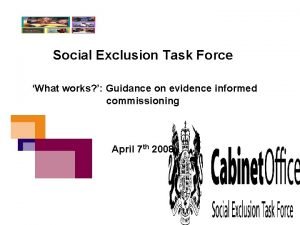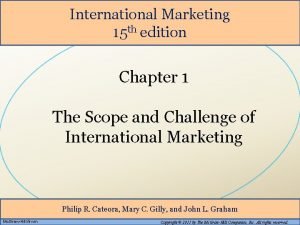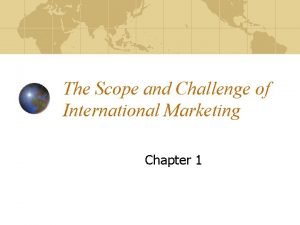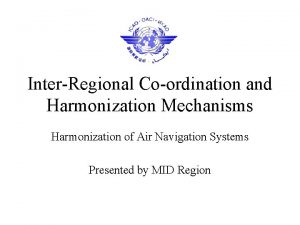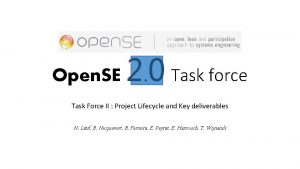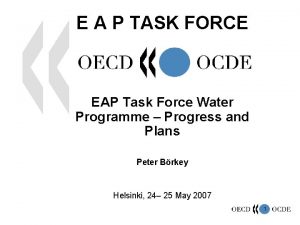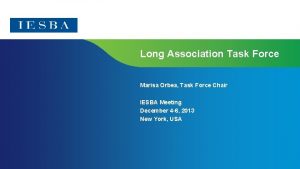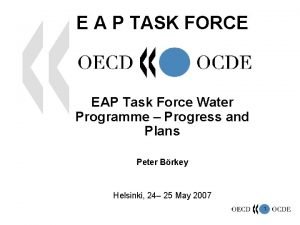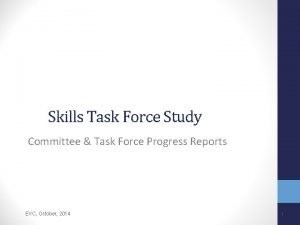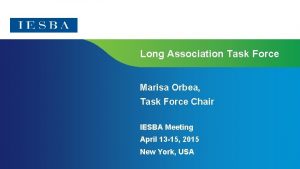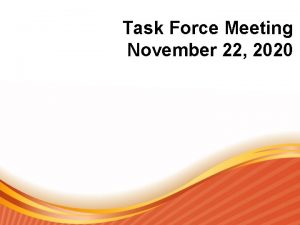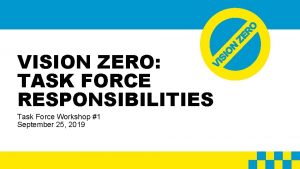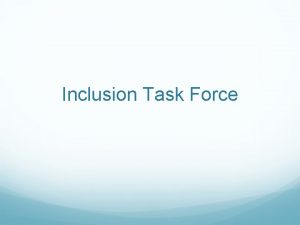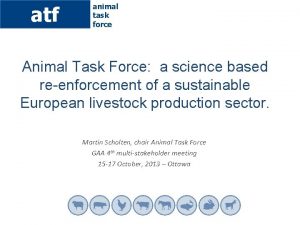The International Task Force on Harmonization and Equivalency





















































































- Slides: 85




The International Task Force on Harmonization and Equivalency in Organic Agriculture (ITF)

Why an ITF? Organic trade continues to grow at the rate of 15%-20% per year worldwide

Why an ITF? Organic trade continues to grow at the rate of 15%-20% per year worldwide Over 100 countries are exporting certified organic products

Why an ITF? Organic trade continues to grow at the rate of 15%-20% per year worldwide Over 100 countries are exporting certified organic products Over 400 public and private certification bodies in global organic marketplace

Why an ITF? (cont. ) Presence of many governmental and private standards and technical regulations governing organic production and certification

Why an ITF? (cont. ) Presence of many governmental and private standards and technical regulations governing organic production and certification Mutual recognition and equivalency among these systems is extremely limited

Why an ITF? (cont. ) Burden on producers and traders that need multiple certifications to access different markets

Why an ITF? (cont. ) Burden on producers and traders that need multiple certifications to access different markets Multitude of standards and certification requirements are a major obstacle to the growth of the organic sector, especially in developing countries

Birth of the ITF In 2001, IFOAM, FAO and UNCTAD joined forces to search for solutions to the problems in the global organic marketplace

Birth of the ITF In 2001, IFOAM, FAO and UNCTAD joined forces to search for solutions to the problems in the global organic marketplace Conference on International Harmonization and Equivalence in Organic Agriculture was held in Nuremburg, Germany in February, 2002

Birth of the ITF (Cont. ) 210 participants from 52 countries concluded that a multi-stakeholder task force should be established to elaborate practical proposals and solutions

Birth of the ITF (Cont. ) 210 participants from 52 countries concluded that a multi-stakeholder task force should be established to elaborate practical proposals and solutions In 2003, the International Task Force on Harmonization (ITF) was formed

Who is the ITF?

Who is the ITF? Representatives of governments, inter-governmental agencies and key stakeholders from the private sector

Who is the ITF? Representatives of governments, inter-governmental agencies and key stakeholders from the private sector Government agencies of 29 countries including Argentina, Australia, Dominican Republic, Germany, India, Indonesia, Thailand, Tunisia, Uganda, and USA

Who is the ITF? (Cont. ) Eight inter-governmental agencies: OECD, FAO, ITC, UNCTAD, UNECE, UNEP, EU Commission, and WTO

Who is the ITF? (Cont. ) Eightinter-governmental agencies: OECD, FAO, ITC, UNCTAD, UNECE, UNEP, EU, and WTO Sixteen private sector organizations and businesses including certification bodies, international standards-setting and accrediting organizations and traders

Goals of the ITF Reduce organic trade barriers

Goals of the ITF Reduce organic trade barriers Seek solutions to facilitate international organic trade and access of developing countries to international organic markets

Goals of the ITF (Cont. ) Be a platform for dialogue between private and public institutions involved in trade and regulatory activities in the organic agriculture sector

Goals of the ITF (Cont. ) Be a platform for dialogue between private and public institutions involved in trade and regulatory activities in the organic agriculture sector Focus on opportunities for harmonization, recognition, equivalence and other forms of cooperation within and between government and private sector organic guarantee systems

Goals of the ITF (Cont. ) Produce tools that can be used by governments and the private sector to streamline acceptance of products that are traded internationally

Phase 1: Review and Analysis (2003 - 2005)

Process Review organic standards, regulations and conformity assessment systems

Process Review organic standards, regulations and conformity assessment systems Analyze the impact of existing organic regulations on trade

Process Review organic standards, regulations and conformity assessment systems Analyze the impact of existing organic regulations on trade Examine current models and mechanisms that enable organic trade

Process (Cont. ) Review experiences of cooperation, in the organic sector to facilitate trade and market access

Process (Cont. ) Review experiences of cooperation, in the organic sector to facilitate trade and market access Examine models and mechanisms From other sectors that facilitate trade and market access

Process (Cont. ) Identify best pathways for establishing equivalence and mutual recognition in the organic sector

Process (Cont. ) Identify best pathways for establishing equivalence and mutual recognition in the organic sector Agree on a long-term strategy and medium-term action plan

Phase 2: Formulations of Proposals and Tools for Solutions (2005 - 2008)

Criteria for Solutions should support the continued growth of organic agriculture and maintain its principles

Criteria for Solutions should support the continued growth of organic agriculture and maintain its principles Beneficial to both producers and consumers

Criteria for Solutions (Cont. ) Respect for national sovereignty

Criteria for Solutions (Cont. ) Respect for national sovereignty Access to all markets with minimal bureaucracy

Criteria for Solutions (Cont. ) Respect for national sovereignty Access to all markets with minimal bureaucracy Fair competition

Criteria for Solutions (Cont. ) Consumer protection

Criteria for Solutions (Cont. ) Consumer protection Stakeholder support and participation

Criteria for Solutions (Cont. ) Consumer protection Stakeholder support and participation Market choice and transparency

Proposals for Solutions: Standards and Equivalence Retain two international reference standards for organic production (Codex and IFOAM), as a basis for regional and national standards

Proposals for Solutions: Standards and Equivalence Retain two international reference standards for organic production (Codex and IFOAM), as a basis for regional and national standards Use a common mechanism for the judgment of equivalence

Proposals for Solutions: Certification and Recognition Use one international performance requirement for organic certification to recognize certification bodies

Proposals for Solutions: Stakeholder Cooperation Promote cooperation within and among government and private sectors to streamline trade

Tools and Recommendations

Tools for Solutions International Requirements for Organic Certifying Bodies (IROCB)

Tools for Solutions International Requirements for Organic Certifying Bodies (IROCB) Tool for recognizing organic certification bodies

Tools for Solutions International Requirements for Organic Certifying Bodies (IROCB) Tool for recognizing organic certification bodies International norm based on ISO 65 for the organic sector

Tools for Solutions International Requirements for Organic Certifying Bodies (IROCB) Developed through a broad consultation process with stakeholders

Tools for Solutions International Requirements for Organic Certifying Bodies (IROCB) Developed through a broad consultation process with stakeholders For governments and private accreditation and certification bodies to be used as a means for accepting certification of products outside their own system

Tools for Solutions Equi. Tool

Tools for Solutions Equi. Tool for assessing and determining the equivalency of production and processing standards

Tools for Solutions Equi. Tool for determining the equivalency of production and processing standards Consists of procedures and criteria for assessing and deciding when an organic standard applicable in one region of the world is equivalent to a standard in another region

Recommendations Countries make every effort to utilize ITF results in order to facilitate trade

Recommendations Countries make every effort to utilize ITF results in order to facilitate trade Equivalence of organic standards is based on the ITF Guidelines for Equivalency (Equi. Tool)

Recommendations (Cont. ) Governments commit to using the two international standards (Codex and IFOAM) as the reference point for import approvals

Recommendations (Cont. ) Governments commit to using the two international standards (Codex and IFOAM) as the reference point for import approvals Public-private participation in the development/decision of both Codex Organic Guidelines and IFOAM standards is improved

Recommendations (Cont. ) The International Requirements for Organic Certification Bodies (IROCB) serve as a benchmark for recognizing certification bodies and accepting organic product certification

Recommendations (Cont. ) Governments and private accreditation systems should take initiatives to develop mutual recognition agreements based on the IROCB

Recommendations (Cont. ) Governments and private accreditation systems should take initiatives to develop mutual recognition agreements based on the IROCB The IROCB should also serve in the long term as a catalyst for convergence on a single international requirement

Recommendations (Cont. ) The IROCB may serve as a basis for direct accreditation when possible

Recommendations (Cont. ) The IROCB serve as a basis for direct accreditation when possible Consideration should be given to emerging alternatives to third party certification such as participatory guarantee systems

Publications

The Benefits to Stakeholders

BENEFITS TO STAKEHOLDERS Organic Farmers Access to markets and increased standard of living

BENEFITS TO STAKEHOLDERS Organic Farmers Access to markets and increased standard of living Not having to get multiple certifications to access markets in various countries

BENEFITS TO STAKEHOLDERS Organic Traders One tool for many different markets would greatly simplify the process

BENEFITS TO STAKEHOLDERS Organic Traders One tool for many different markets would greatly simplify the process Lower costs in both sourcing and selling organic products and ingredients

BENEFITS TO STAKEHOLDERS Organic Certifiers Lower costs and increase direct client services

BENEFITS TO STAKEHOLDERS Organic Certifiers Lower costs and increase direct client services Streamline certification processes

BENEFITS TO STAKEHOLDERS Organic Certifiers Lower costs and increase direct client services Streamline certification processes Avoid having to get multiple accreditations

BENEFITS TO STAKEHOLDERS Governments: Exporting Countries Improve access of country’s organic agricultural products to world markets, bring opportunity for new trading partners

BENEFITS TO STAKEHOLDERS Governments: Exporting Countries Improve access of country’s organic agricultural products to world markets, bring opportunity for new trading partners Reduce costs and provide increased economic opportunity for citizens

BENEFITS TO STAKEHOLDERS Governments: Importing Countries Greater availability of products and improve our service to our constituents

BENEFITS TO STAKEHOLDERS Governments: Importing Countries Greater availability of products and improve our service to our constituents Streamline process and increase efficiency in regulating organic imports

BENEFITS TO STAKEHOLDERS Intergovernmental Organizations Increasing the global organic marketplace improves the environment and contributes to alleviating world poverty

BENEFITS TO STAKEHOLDERS Intergovernmental Organizations Increasing the global organic marketplace improves the environment and contributes to alleviating world poverty

BENEFITS TO STAKEHOLDERS Organic Retailers Greater selection of products for consumers

BENEFITS TO STAKEHOLDERS Organic Retailers Greater selection of products for consumers Support greater number of developing countries who have joined the organic marketplace

BENEFITS TO STAKEHOLDERS Organic Consumers More availability and choices of organic products

BENEFITS TO STAKEHOLDERS Organic Consumers More availability and choices of organic products Support farmers in developing countries

BENEFITS TO STAKEHOLDERS Organic Consumers More availability and choices of organic products Support farmers in developing countries

For More Information www. itf-organic. org
 Global harmonization task force
Global harmonization task force Equivalency theory and distance education
Equivalency theory and distance education Vilazadone
Vilazadone Uncc writing intensive courses
Uncc writing intensive courses Meal equivalent factor
Meal equivalent factor Uncg course equivalency
Uncg course equivalency False equivalence
False equivalence Habitat equivalency analysis
Habitat equivalency analysis Grade harmonisation
Grade harmonisation Data harmonization best practices
Data harmonization best practices Tiered task bias task
Tiered task bias task S330 nwcg
S330 nwcg Enemy mechanized infantry symbol
Enemy mechanized infantry symbol Glencoe sustainability task force
Glencoe sustainability task force R.e.a.c.t. task force
R.e.a.c.t. task force Iowa food protection task force
Iowa food protection task force 40 recommendations of fatf
40 recommendations of fatf Green ribbon task force
Green ribbon task force Princeton policy task force
Princeton policy task force Desktop management task force
Desktop management task force Anchor institutions task force
Anchor institutions task force Social performance task force
Social performance task force Marketing task force
Marketing task force Combined joint task force horn of africa
Combined joint task force horn of africa North orange county public safety task force
North orange county public safety task force Ctfphc
Ctfphc Friendly armor battalion task force symbol
Friendly armor battalion task force symbol Iowa food protection task force
Iowa food protection task force Apa presidential task force on evidence-based practice
Apa presidential task force on evidence-based practice Jidf
Jidf Social exclusion task force
Social exclusion task force Appell musterlösung
Appell musterlösung South florida ecosystem restoration task force
South florida ecosystem restoration task force Born with a mic flocabulary
Born with a mic flocabulary A feature of infrequent foreign marketing is that it
A feature of infrequent foreign marketing is that it The international marketing task
The international marketing task Centripetal force and gravitational force
Centripetal force and gravitational force Normal force and gravitational force
Normal force and gravitational force Internal force examples
Internal force examples Hát kết hợp bộ gõ cơ thể
Hát kết hợp bộ gõ cơ thể Frameset trong html5
Frameset trong html5 Bổ thể
Bổ thể Tỉ lệ cơ thể trẻ em
Tỉ lệ cơ thể trẻ em Voi kéo gỗ như thế nào
Voi kéo gỗ như thế nào Tư thế worm breton là gì
Tư thế worm breton là gì Chúa yêu trần thế alleluia
Chúa yêu trần thế alleluia Môn thể thao bắt đầu bằng chữ f
Môn thể thao bắt đầu bằng chữ f Thế nào là hệ số cao nhất
Thế nào là hệ số cao nhất Các châu lục và đại dương trên thế giới
Các châu lục và đại dương trên thế giới Công thức tiính động năng
Công thức tiính động năng Trời xanh đây là của chúng ta thể thơ
Trời xanh đây là của chúng ta thể thơ Mật thư tọa độ 5x5
Mật thư tọa độ 5x5 Phép trừ bù
Phép trừ bù Phản ứng thế ankan
Phản ứng thế ankan Các châu lục và đại dương trên thế giới
Các châu lục và đại dương trên thế giới Thơ thất ngôn tứ tuyệt đường luật
Thơ thất ngôn tứ tuyệt đường luật Quá trình desamine hóa có thể tạo ra
Quá trình desamine hóa có thể tạo ra Một số thể thơ truyền thống
Một số thể thơ truyền thống Cái miệng nó xinh thế
Cái miệng nó xinh thế Vẽ hình chiếu vuông góc của vật thể sau
Vẽ hình chiếu vuông góc của vật thể sau Nguyên nhân của sự mỏi cơ sinh 8
Nguyên nhân của sự mỏi cơ sinh 8 đặc điểm cơ thể của người tối cổ
đặc điểm cơ thể của người tối cổ V cc
V cc Vẽ hình chiếu đứng bằng cạnh của vật thể
Vẽ hình chiếu đứng bằng cạnh của vật thể Tia chieu sa te
Tia chieu sa te Thẻ vin
Thẻ vin đại từ thay thế
đại từ thay thế điện thế nghỉ
điện thế nghỉ Tư thế ngồi viết
Tư thế ngồi viết Diễn thế sinh thái là
Diễn thế sinh thái là Dạng đột biến một nhiễm là
Dạng đột biến một nhiễm là Số nguyên tố là
Số nguyên tố là Tư thế ngồi viết
Tư thế ngồi viết Lời thề hippocrates
Lời thề hippocrates Thiếu nhi thế giới liên hoan
Thiếu nhi thế giới liên hoan ưu thế lai là gì
ưu thế lai là gì Khi nào hổ con có thể sống độc lập
Khi nào hổ con có thể sống độc lập Khi nào hổ mẹ dạy hổ con săn mồi
Khi nào hổ mẹ dạy hổ con săn mồi Hệ hô hấp
Hệ hô hấp Từ ngữ thể hiện lòng nhân hậu
Từ ngữ thể hiện lòng nhân hậu Thế nào là mạng điện lắp đặt kiểu nổi
Thế nào là mạng điện lắp đặt kiểu nổi Is tension force contact or noncontact
Is tension force contact or noncontact What force provides centripetal force
What force provides centripetal force Long range force vs contact force
Long range force vs contact force What force provides centripetal force
What force provides centripetal force The ratio of resistance force to effort force
The ratio of resistance force to effort force
